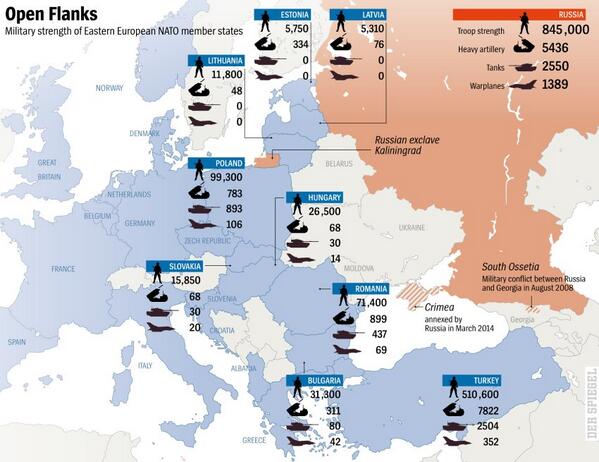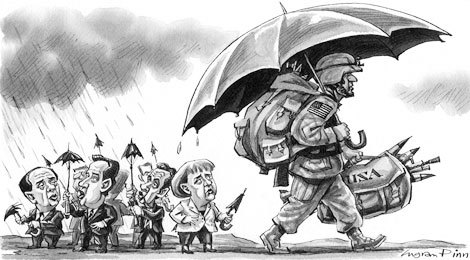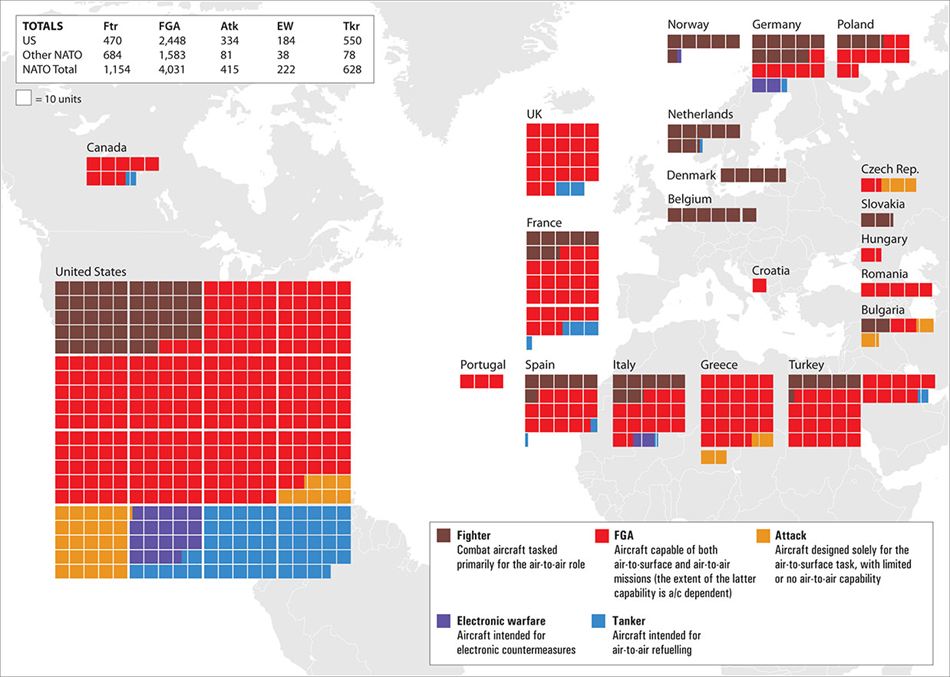NATO considers strengthening defences in eastern Europe over Russia’s illegal military actions in Ukraine
By Matthew Fisher

NATO Secretary General Anders Fogh Rasmussen gives his monthly press conference on May 19, 2014 at the Residence Palace building in Brussels. Rasmussen said he had seen no proof of Russian troops withdrawing from the border with Ukraine after President Vladimir Putin announced an end to exercises and return to bases. "Unfortunately, we have not seen any evidence at all that Russia has started withdrawal," Rasmussen said.


Q. I gather some of countries such as Poland would welcome such a development?

 Canadian Royal Navy ship HMCS Regina cruises in the Huangpu River in Shanghai, China, Canadian warship reassigned to NATO forces in Europe heading to the Mediterranean
Canadian Royal Navy ship HMCS Regina cruises in the Huangpu River in Shanghai, China, Canadian warship reassigned to NATO forces in Europe heading to the Mediterranean


After two decades of trying to build a partnership with Russia, the Nato alliance now feels compelled to start treating Moscow as an adversary
 Ukrainian troops guard on the road from Izyum to Slavyansk on May 19, 2014
Ukrainian troops guard on the road from Izyum to Slavyansk on May 19, 2014

NATO Secretary General Anders Fogh Rasmussen gives his monthly press conference on May 19, 2014 at the Residence Palace building in Brussels. Rasmussen said he had seen no proof of Russian troops withdrawing from the border with Ukraine after President Vladimir Putin announced an end to exercises and return to bases. "Unfortunately, we have not seen any evidence at all that Russia has started withdrawal," Rasmussen said.
NATO is considering whether to ask Canada and other member countries to establish permanent bases in the Baltic states, Poland, Romania and Bulgaria — or establish a regular rotation of troops through those countries — to shore up its eastern defences following Russia’s seizure of Crimea and threats against eastern Ukraine, Secretary General Anders Fogh Rasmussen said Monday. Russian President Vladimir Putin’s actions in Crimea and eastern Ukraine were a “wake-up call” that had “unintentionally” made the trans-Atlantic alliance stronger, Rasmussen said. Putin promised for the third time Monday that Russia was withdrawing the 40,000 troops that it has deployed for several months near Ukraine’s eastern borders, but the former Danish prime minister said there had been no sign of this.The following is a transcript of the interview with NATO Secretary General Anders Fogh Rasmussen.

United States was to move aircraft based in the UK to Lithuania, as well as increasing air force exercises in eastern Europe
Q. Canada had permanent military bases, two of them in Germany, until about 1992 or 1993. Can you envisage a day when, because of this crisis, Canada and the United States might bring troops back to be based in eastern Europe such as the Baltic states, Poland, Romania and Bulgaria or on a permanent rotation basis such as U.S. marines are now doing in Asia?
A. Clearly we will need a more visible NATO presence all over NATO territory, including our eastern allies. But it is a bit too early to say exactly how such deployments would take place. As you mentioned yourself, it could be on a rotational basis. Right now we are in the phase where we are considering options. The aim is to improve readiness and responsiveness. I would expect the NATO summit [in Wales] in September to take decisions on such long-term measures to reinforce collective defence.

Q. I gather some of countries such as Poland would welcome such a development?
A. It is no secret that eastern allies argue that they need a stronger NATO presence in their territory as a kind of deterrent so that any potential aggressor would not even think of attacking our eastern allies. We are now in the process of considering different options. It is a bit too early to say how or where such reinforcements could take place. Taking into account the new security situation in Europe, we have to adapt. We have to improve our readiness and responsiveness because we have seen Russia being capable to act very quickly.

First US ground troops head to Eastern Europe to bolster security
Q. Are you satisfied with Canada’s response regarding Ukraine?
A. I am very satisfied. Canada has responded quickly by sending aircraft to Romania and also a naval vessel.
Q. Do you want more from Canada?
A. I am very satisfied. Canada has responded quickly by sending aircraft to Romania and also a naval vessel.
Q. Do you want more from Canada?
A. That remains to be seen. We are considering further steps to reinforce collective defence and I hope that all 28 allies will contribute in that respect.
Q. A Canadian warship has joined four or five other NATO warships in the Mediterranean. Will they be going into the Black Sea?
A. We never comment on operational details. I can confirm that we have reinforced our naval presence in the eastern Mediterranean. Further movement will very much depend on the security situation. And you have seen individual allies deploy ships into the Black Sea. So, all in all, you see a greater naval presence in the Black Sea.

Q. Vladimir Putin told us for the third time today that Russian troops are pulling back. Has NATO seen any evidence of this?
A. We haven’t see any evidence of withdrawal of Russian troops from the Ukrainian border. It is now the third statement from Putin and still no withdrawal has taken place. Clear evidence would to be to see Russian troops move in a meaningful way away from the Ukrainian border. Of course we have satellite images and other ways of demonstrating that. If we saw a meaningful withdrawal I would be the first person to welcome it because that would be an important contribution to de-escalating the crisis.

Russian troops on Ukraine border
Q. How are the Russian troops presently deployed? What are they doing there?
A. What are they doing there is a very good question. They have up to 40,000 troops massed along the Ukrainian border. They are very close to the Ukrainian border. They are at a high level of readiness. If the political decision were taken in the Kremlin to invade eastern Ukraine they would be able to act very quickly. They have a broad range of capabilities that are clearly prepared for an offensive action.

In March 2014 Russia invaded Ukraine and annexed Crimea region.
Q. If they were leaving would you see that very quickly?
A. Yes, of course, if a substantial part of the 40,000 troops or the 40,000 troops were to withdraw, it would be very visible. I believe the whole purpose of this buildup of strong military forces along the Ukrainian border was to destabilize the situation in Ukraine. It is a multifaceted operation. They sent in secret agents from their secret services. They are trying to stir up the crisis in eastern Ukraine. They give advice to armed pro-Russian separatists. They even provide weapons and help organize violent actions. Due to the massive buildup of troops along Ukraine’s eastern border they try to deter Ukrainian authorities from taking determined actions against the illegal operations by pro-Russian separatists in eastern Ukraine … and create, maybe, a further pretext for intervention. That is an option that they, at least, keep open.
Q. What is NATO’s assessment of how much better the Russian forces are now than they were in Chechnya or Georgia?
A. Compared to what we saw during the Georgian war, we have seen much more capable Russian forces, more modern, better organized and, first and foremost, ready to act swiftly. They can easily turn their major exercises into an attack if they so decide politically. This is exactly why we have to adapt to the new situation.
 Ukrainian troops guard on the road from Izyum to Slavyansk on May 19, 2014
Ukrainian troops guard on the road from Izyum to Slavyansk on May 19, 2014
Q. How do you get Canada and other member countries to reach the NATO target of two per cent of GDP on military spending? (Canada spends about one per cent of GDP on defence.)
A. The illegal Russian military actions in Ukraine are a wake up call. It is a clear demonstration of the fact that we cannot take security and stability for granted in our part of the world. During more than 20 years since the end of the Cold War we have based our military planning on the assumption that Russia does not constitute an imminent threat toward NATO allies. But we have learned in Ukraine that Russia reserves the right to intervene in other countries. That should be a wake up call in all capitals. The fact is that during the past five years Russia has increased its defence spending by 10 per cent per year. At the same time NATO allies have cut their budgets drastically. That must be reversed. Actual events in Ukraine will be the strongest argument in favour of increased defence spending and why defence matters. Events in Ukraine have put a lot of focus on one of NATO’s core tasks, namely the territorial defence of our populations and societies. So, unintentionally, Putin has contributed to strengthening the trans-Atlantic bond. People have now been reminded how important it is. After the Cold War people took our security for granted. We have now learned we cannot take it for granted. We have to stand together and defend our societies in a unified way.
------------------------------------------------------------
Some aditional data...


EU and NATO Aircraft power



EU and NATO Aircraft power

The U.S. has 28 main operating bases in Europe, primarily in Germany, Italy, the United Kingdom, Turkey, and Spain. The number of U.S. installations in Europe has declined steadily since the Cold War. For example, in 1990, the U.S. Army had more than 850 sites in Europe, but today the total number for all services is approximately 350.
Related

No comments:
Post a Comment